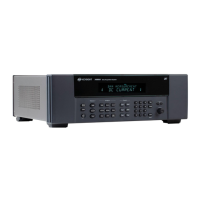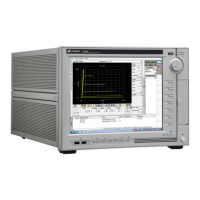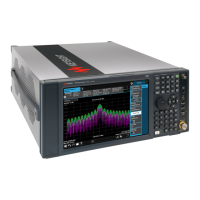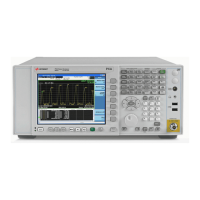4 Theory of Operation
120 Keysight 34420A Service Guide
A-to-D Converter
This discussion refers to the A/D Converter schematic on page 164. The
analog-to-digital converter (ADC) changes dc voltages into digital information.
The circuitry consists of an integrator amplifier (U402 and U420), current steering
switch U411, resistor network U102E, and voltage reference U403. The O or 5 Volt
signal output is sent to the ASIC U501, and residue ADC U500.
The ADC method used by the Keysight 34420A is called Multislope III. It is based
on patented Keysight Technologies ADC technology. Multislope III is a charge
balancing, continuously integrating, analog-to-digital conversion technique. The
ADC charge balancing algorithm is always running, even when the meter is not
triggered. The input voltage continuously forces charge onto the integrator
capacitors C400 and C401 through the 100 kΩ resistor in U102E at pin 15.
Switches 2 and 3 in U411 steer fixed positive or negative reference currents onto
the integrator capacitor to cancel, or balance, the accumulated input charge. The
level shifted (R403 and R406) output of the integrator is checked every 2.66 µs
by the U501 COMP input. Logic state machines in U501 control the U411 current
steering to continuously seek an approximate 2.5 V level on the integrator
amplifier output, FLASH. If the ADC input voltage ADIN is between ± 15 V, the
integrator output (FLASH) will remain within the O to 5 V range of the U50
on-chip ADC. An input greater than +15 V may cause the integrator output
(U402-6) to saturate at about -18 V. An input less than -15 V may cause U402 to
saturate with an output of about +18 V. The U500 ADC input (FLASH) is clamped
to O or 5 V by R405 and CR403 to protect U500.
The integrator amplifier is formed by U402 and U420. Resistors R420 and R421
affect the amplifier stability and prevent amplifier oscillation. Amplifier U420
improves the offset voltage characteristics of integrator amplifier U402.
Each analog-to-digital conversion begins when the meter is triggered. The ADC
starts by clearing the integrator slope count in U501. At the end of the integration
period, the slope count is latched. The slope count provides the most significant
bits of the input voltage conversion. The least significant bits are converted by the
on-chip ADC of CPU U500.
The precision voltage reference is U403. Resistor R409 provides a stable bias
current for the reference zener diode. R408 and CR404 provide a bias to assure
that the reference zener biases to +7 V during power up. IC U400A amplifies the
voltage reference to +10 V while amplifier U401A inverts the +10 V reference to
-10 V. The reference voltages force precision slope currents for the integrating

